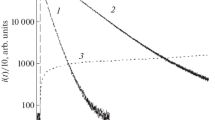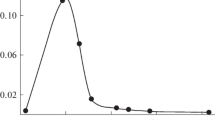Summary
The luminescence of aqueous solutions of Tl+ during irradiation with 8.5-keV-X-rays has been investigated. In particular we have studied the Tl+-luminescence in 1. neutral solutions, 2. acid solutions, 3. alkaline solutions, 4. solutions containing various concentrations of NaCl.
Varying thepH the luminescence yield passes a maximum on the acid side as well as on the alkaline side (atpH=3.4 respectivelypH=12). Compared with neutral solutions the luminescence yield is increased by a factor 2 to 3 at these pH-values.
By adding 1 M NaCl to neutral Tl+-solutions the luminescence yield is enhanced by a factor five, however in dependence ofpH no further increase has been observed, but only quenching of the luminescence at low and highpH.
The luminescence origins from the formation of Tl+* by the reaction of eaq with Tl++ formed by oxidation of Tl+ by OH. However, Tl++ is not formed directly by Tl++OH→ Tl++ + OH− but via dissociation of the intermediate Tl+OH after a delay > 10−7 sec.
We explain the increase of the luminescence yield in acid solutions by the reaction Tl+OH + H+ → Tl++ + H2O and in alkaline solutions by the reaction Tl+OH + OH− → Tl++O− + H2O. In alkaline solutions the luminescence spectrum shifts to longer wavelengths; we conclude, that this spectrum is attributed to Tl+*O−. Evidently the reaction of Tl+Cl− and Tl+Cl2 −− with OH leads to formation of Tl++Cl− and Tl++Cl2 −− without any efficient delay.
Zusammenfassung
Die Lumineszenz wÄ\riger Tl+-Lösungen unter Einwirkung von 8,5-keVeff-Röntgenstrahlen wird untersucht, und zwar 1. in neutraler Lösung, 2. in saurer Lösung, 3. in alkalischer Lösung, 4. bei Zusatz von NaCl.
Bei Änderung des pH-Wertes nimmt die Lichtausbeute sowohl auf der sauren Scite (beipH=3,4) als auch auf der alkalischen Scite (beipH=12) ein Maximum an; sie erreicht dort den 2- bis 3fachen Wert der Ausbeute in neutraler Lösung. Andererseits ist bei Zusatz von 1 M NaCl in neutraler Lösung die Ausbeute fünfmal höher als bei Abwesenheit von NaCl; die Maxima im sauren und alkalischen Bereich verschwinden jedoch bei 1 M NaCl vollkommen, und man erhÄlt bei gro\en und bei kleinen pH-Werten lediglich eine Löschung der Lumineszenz.
Die Lumineszenz kommt durch Bildung von Tl+* bei der Anlagerung von eaq an Tl++ zustande. Tl++ entsteht jedoch nicht unmittelbar gemÄ\ Tl+ + OH → Tl++ + OH−, sondern zunÄchst bildet sich Tl+OH, und dieses dissoziiert erst nach einer Verzögerung von > 10−7 sec in Tl++ und OH−. Die Sensibilisierung durch H+ wird durch die Reaktion Tl+OH + H+ → Tl++ + H2O und die durch OH− durch Tl+OH + OH− → Tl++O− + H2O erklÄrt. Die Reaktion der Komplexe Tl+Cl− und Tl+Cl2 − mit OH erfolgt offenbar ohne zeitliche Verzögerung, d. h. Tl++Cl−− bzw. Tl++Cl2 −− wird dabei innerhalb einer Zeit ≪ 10−7 sec gebildet.
Similar content being viewed by others
Literatur
Adams, G. E.: Pulse radiolysis, p. 136. London: Academic Press 1965.
Anbar, M., and P. Neta: Int. J. appl. Radiat.16, 227 (1965).
Cercek, B., M. Ebert, and A. J. Swallow: J. chem. Soc. (A)1966, 612 (1966).
Grossweiner, L. I., and A. F. Rodde: J. phys. Chem.72, 766 (1968).
Kuo-Hao Hu, and A. B. Scott: J. chem. Phys.23, 1830 (1955).
Jörgensen, C. K.: Inorganic complexes, p. 27. New York, London: Academic Press 1963.
Kuppermann, A.: The chemical and biological action of radiation. Haissinsky, M., Ed. London: Academic Press 1961.
Pickert, H. H.: Staatsexamensarbeit. Freiburg 1963.
Prütz, W., u. K. Sommermeyer: Biophysik4, 48 (1967).
—, u. E. J. Land: Biophysik3, 349 (1967).
—, K. Sommermeyer and E. J. Land: Nature (Lond.)212, 1043 (1966).
- Private Mitteilung.
Steffen, G., u. K. Sommermeyer: Biophysik5, 192 (1968).
Author information
Authors and Affiliations
Rights and permissions
About this article
Cite this article
Steffen, G., Sommermeyer, K. Die Erzeugung von Chemilumineszenzen wÄ\riger TlI-Salzlösungen durch Röntgenstrahlen. Biophysik 6, 123–136 (1969). https://doi.org/10.1007/BF01195907
Received:
Issue Date:
DOI: https://doi.org/10.1007/BF01195907




